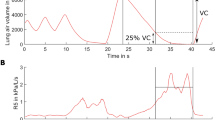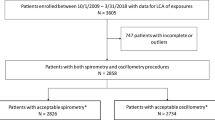Abstract
This study evaluated whether impulse oscillometry (IOS) testing revealed signs of respiratory disease in New York State (NYS) World Trade Center (WTC) responders in comparison with unexposed NYS employees. It also compared self-reported respiratory symptoms between the two groups, 6 years post-9/11. For this evaluation participants completed a self-administered questionnaire regarding respiratory symptoms. IOS testing included measures of resistance and reactance to assess for peripheral versus central airway effects. Two hundred forty-eight subjects (99 exposed and 149 unexposed) were included in the final analysis. Since September 11, 2001, NYS responders were more likely to report new or worsening cough in the absence of a respiratory infection, cough consistent with chronic bronchitis, current respiratory symptoms, or lower respiratory symptoms in the last 12 months. Significant associations were found between IOS indices and gender, smoking history, and obesity. When comparing exposed and unexposed participants, there were no significant differences in the geometric means of the IOS indices. Responders who used a respirator with canister demonstrated significantly lower respiratory resistance at 5 and 20 Hz (R5 and R20). While this study has provided no evidence of an association between WTC exposure and peripheral airways disease in this cohort of responders, results do suggest that use of a respirator with canister may be protective for central airways in responders exposed to dust and smoke. This emphasizes the importance of stressing proper respirator use in planning responses to future disasters. Our control data also provide useful reference values for future IOS research.
Similar content being viewed by others
References
Prezant DJ, Weiden M, Banauch GI, McGuinness G, Rom WN, Aldrich TK, Kelly KJ (2002) Cough and bronchial responsiveness in firefighters at the World Trade Center site. N Engl J Med 347:806–815
Salzman SH, Moosavy FM, Miskoff JA, Friedmann P, Fried G, Rosen MJ (2004) Early respiratory abnormalities in emergency services police officers at the World Trade Center site. J Occup Environ Med 46:113–122
Skloot G, Goldman M, Fischler D, Goldman C, Schechter C, Levin S, Teirstein A (2004) Respiratory symptoms and physiologic assessment of ironworkers at the World Trade Center disaster site. Chest 125:1248–1255
Herbert R, Moline J, Skloot G, Metzger K, Baron S, Luft B, Markowitz S, Udasin I, Harrison D, Stein D, Todd A, Enright P, Stellman JM, Landrigan PJ, Levin SM (2006) The World Trade Center disaster and the health of workers: five-year assessment of a unique medical screening program. Environ Health Perspect 114(12):1853–1858
Mauer MP, Cummings KR, Carlson GA (2007) Health effects in New York State personnel who responded to the World Trade Center disaster. J Occup Environ Med 49:1197–1205
Reibman J, Lin S, Hwang SA, Gulati M, Bowers JA, Rogers L, Berger KI, Hoerning A, Gomez M, Fitzgerald EF (2005) The World Trade Center residents’ respiratory health study: new onset respiratory symptoms and pulmonary function. Environ Health Perspect 113:406–411
Lin S, Reibman J, Bowers JA, Hwang SA, Hoerning A, Gomez MI, Fitzgerald EF (2005) Upper respiratory symptoms and other health effects among residents living near the World Trade Center site after September 11, 2001. Am J Epidemiol 162:499–507
Trout D, Nimgade A, Mueller C, Hall R, Earnest GS (2002) Health effects and occupational exposures among office workers near the World Trade Center disaster site. J Occup Environ Med 44:601–605
Farfel M, DiGrande L, Brackbill R, Prann A, Cone J, Friedman S, Walker DJ, Pezeshki G, Thomas P, Galea S, Williamson D, Frieden TR, Thorpe L (2008) An overview of 9/11 experiences and respiratory and mental health conditions among World Trade Center health registry enrollees. J Urban Health 85(6):880–909
Lioy PJ, Weisel CP, Millette JR, Eisenreich S, Vallero D, Offenberg J, Buckley B, Turpin B, Zhong M, Cohen MD, Prophete C, Yang I, Stiles R, Chee G, Johnson W, Porcja R, Alimokhtari S, Hale RC, Weschler C, Chen LC (2002) Characterization of the dust/smoke aerosol that settled east of the World Trade Center (WTC) in lower Manhattan after the collapse of the WTC 11 September 2001. Environ Health Perspect 110:703–714
Cahill TA, Cliff SS, Perry KD et al (2004) Analysis of aerosols from the World Trade Center collapse site, New York, October 2 to October 30, 2001. Aerosol Sci Technol 38:165–183
Centers for Disease Control and Prevention (CDC) (2002) Occupational exposures to air contaminants at the World Trade Center disaster site-New York, September-October, 2001. MMWR Morb Mortal Wkly Rep 51:453–456
Centers for Disease Control and Prevention (CDC) Potential exposures to airborne and settled surface dust in residential areas of lower Manhattan following the collapse of the World Trade Center–New York City, November 4-December 11, 2001. MMWR Morb Mortal Wkly Rep 52:131-136
McGee JK, Chen LC, Cohen MD, Chee GR, Prophete CM, Haykal-Coates N, Wasson SJ, Conner TL, Costa DL, Gavett SH (2003) Chemical analysis of World Trade Center fine particulate matter for use in toxicologic assessment. Environ Health Perspect 111:972–980
Offenberg JH, Eisenreich SJ, Gigliotti CL, Chen LC, Xiong JQ, Quan C, Lou X, Zhong M, Gorczynski J, Yiin LM, Illacqua V, Lioy PJ (2004) Persistent organic pollutants in dusts that settled indoors in lower Manhattan after September 11, 2001. J Expo Anal Environ Epidemiol 14:164–172
Oppenheimer BW, Goldring RM, Herberg ME, Hofer IS, Reyfman PA, Liautaud S, Rom WN, Reibman J, Berger KI (2007) Distal airway function in symptomatic subjects with normal spirometry following World Trade Center dust exposure. Chest 132:1125–1282
Landrigan PJ, Lioy PJ, Thurston G, Berkowitz G, Chen LC, Chillrud SN, Gavett SH, Georgopoulos PG, Geyh AS, Levin S, Perera F, Rappaport SM, Small C, NIEHS World Trade Center Working Group (2004) Health and environmental consequences of the World Trade Center disaster. Environ Health Perspect 112:731–739
Mendelson DS, Roggeveen M, Levin SM, Herbert R, de la Hoz RE (2007) Air trapping detected on end-expiratory high-resolution computed tomography in symptomatic World Trade Center rescue and recovery workers. J Occup Environ Med 49:840–845
Goldman MD, Saadeh C, Ross D (2005) Clinical applications of forced oscillation to assess peripheral airway function. Respir Physiol Neurobiol 148:179–194
Oostveen E, MacLeod D, Lorino H, Farré R, Hantos Z, Desager K, Marchal F, ERS Task Force on Respiratory Impedance Measurements (2003) The forced oscillation technique in clinical practice: methodology, recommendations and future developments. Eur Respir J 22:1026–1041
Goldman MD (2001) Clinical applications of forced oscillation. Pulm Pharmacol Ther 14(5):341–350
Mansur AH, Manney S, Ayres JG (2008) Methacholine-induced asthma symptoms correlate with impulse oscillometry but not spirometry. Respir Med 102:42–49
Vink GR, Arets HG, van der Laag J, van der Ent CK (2003) Impulse oscillometry: a measure for airway obstruction. Pediatr Pulmonol 35:214–219
Kahan ES, Martin UJ, Spungen S, Ciccolella D, Criner GJ (2007) Chronic cough and dyspnea in ice hockey players after an acute exposure to combustion products of a faulty ice resurfacer. Lung 185(1):47–54
Olaguibel JM, Alvarez-Puebla MJ, Anda M, Gómez B, García BE, Tabar AI, Arroabarren E (2005) Comparative analysis of the bronchodilator response measured by impulse oscillometry (IOS), spirometry and body plethysmography in asthmatic children. J Invest Allergol Clin Immunol 15(2):102–106
Malmberg LP, Makela MJ, Mattila PS, Hammarén-Malmi S, Pelkonen AS (2008) Exercise-induced changes in respiratory impedance in young wheezy children and nonatopic controls. Pediatr Pulmonol 43:538–544
Park JW, Lee YW, Jung YH, Park SE, Hong CS (2007) Impulse oscillometry for estimation of airway obstruction and bronchodilation in adults with mild obstructive asthma. Ann Allergy Asthma Immunol 98(6):546–552
Song TW, Kim KW, Kim ES, Kim KE, Sohn MH (2008) Correlation between spirometry and impulse oscillometry in children with asthma. Acta Paediatr 97:51–54
Al-Mutairi SS, Sharma PN, Al-Alawi A, Al-Deen JS (2007) Impulse oscillometry: an alternative modality to the conventional pulmonary function test to categorise obstructive pulmonary disorders. Clin Exp Med 7:56–64
Evans TM, Rundell KW, Beck KC, Levine AM, Baumann JM (2005) Airway narrowing measured by spirometry and impulse oscillometry following room temperature and cold temperature exercise. Chest 128:2412–2419
Herdt-Losavio ML, Mauer MP, Carlson GA (2008) Development of an exposure assessment method for epidemiological studies of New York State personnel who responded to the World Trade Center disaster. Ann Occup Hyg 52:83–93
de la Hoz RE, Shohet MR, Chasan R, Bienenfeld LA, Afilaka AA, Levin SM, Herbert R (2008) Occupational toxicant inhalation injury: the World Trade Center (WTC) experience. Int Arch Occup Environ Health 81:479–485
Acknowledgments
The authors thank Janine Palome, RN, BSN, with the NYSDOH, for her valuable contributions to data collection for this study. They are also grateful to Rebecca Hoen, MS, also with the NYSDOH, for her assistance in data review. This work was supported by the Centers for Disease Control and Prevention (CDC) [Cooperative Agreement Number U1Q/CCU221059]. Its contents are solely the responsibility of the authors and do not necessarily represent the official views of CDC.
Author information
Authors and Affiliations
Corresponding author
Rights and permissions
About this article
Cite this article
Mauer, M.P., Cummings, K.R. Impulse Oscillometry and Respiratory Symptoms in World Trade Center Responders, 6 Years Post-9/11. Lung 188, 107–113 (2010). https://doi.org/10.1007/s00408-009-9206-y
Received:
Accepted:
Published:
Issue Date:
DOI: https://doi.org/10.1007/s00408-009-9206-y




